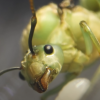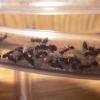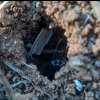Camponotus vicinus
Abstract
Camponotus vicinus is a large species of Camponotus in the subgenus (Tanaemyrmex). Camponotus (Tanaemyrmex) species such as C. vicinus and C. semitestaceus are distinct from common species in subgenus Camponotus (Camponotus) such as C. pennsylvanicus and C. modoc, as their exoskeletons are generally shinier than their dull counterparts, and their legs are longer and lankier. Workers and queens are typically larger, thought this is not always the case. It is native to the western United States and Canada, preferring to live in high elevation, mountainous regions. Unlike many species of Camponotus, C. vicinus do not typically nest in wood, and are therefore not technically 'carpenter ants', though they are similar to wood-dwelling Camponotus in many other ways. Colonies are usually found in soil under stones. Nesting in or under wood is the exception, not the rule. Colonies are polydomous, meaning they can have multiple nest locations. In the case of C. vicinus, this often means colonies claim multiple stones, as if separate cities connected by their pheromone trail highways. Queens are 16-20 mm long and workers are 7-15 mm long. Like most Camponotus, C. vicinus is polymorphic, with the large major workers possessing fat, muscular heads.
Many populations of Camponotus vicinus are known to be polygynous (colonies tolerate multiple queens), which is fairly unique among large ant species, as polygynous species tend to trend smaller than their monogynous counterparts. Not all populations of C. vicinus are polygynous, however; many are monogynous like the majority of Camponotus species and ant species in general. Monogynous C. vicinus are easily distinguished from polygynous C. vicinus, as they will immediately show signs of aggression when put in the same enclosure/space of another queen. This aggression may include lunging with mandibles agape and the gaster curling forwards to spray formic acid before the expected biting occurs. Queens demonstrating aggression should be separated immediately. Polygynous populations will not show aggression towards each other, and will adversely touch antennae, groom each other, and huddle close together in groups.
As with all Camponotus species, C. vicinus are omnivores, requiring sugary foods to fuel the adult workers and protein from insects for the growing larvae and to aid the queen in producing eggs. Since they are large ants, brood development is slow, with nanitics arriving in roughly 8 weeks after the queens first lay eggs.
Resources
Journals:
There appears to be a lack of journals documenting a mature colony of this species, or even a colony over 100 workers, as most journals tend to fade away
after a few months. I intend to change that. As you will see, I have no shortage of resources for this species.
Articles:
Camponotus vicinus (Neighbor Carpenter Ant) Care Sheet – Canada Ant Colony
Reference genome of the bicolored carpenter ant, Camponotus vicinus - PMC
Camponotus vicinus - Navajo Nature
Camponotus modoc
Abstract
Camponotus modoc is a species in the subgenus (Camponotus). Like C. vicinus, it is found throughout the western United States and Canada. These are a species of carpenter ant, with colonies frequently nesting in and under rotting wood. A common misconception with carpenter ants is that they eat wood. While this is true of termites, who both eat and nest in wood, ants lack the enzymes necessary to digest wood, and instead only nest in it. Colonies will occasionally nest in soil under stones, though this is the exception, not the rule. They seem to be slightly more adaptable than C. vicinus, nesting in a wide variety of habitats from forests, mountains, and open plains, wherever there is wood to inhabit. They are similar to and related to Camponotus pennsylvanicus, whose range trends east of C. modoc. Most C. modoc populations are west of the Rocky Mountains, while most C. pennsylvanicus populations are east of the Rockies. There are some regions where the two species overlap, however. The Black Hills of South Dakota, of which I am well acquainted, is east of the Rockies yet still in the western United States. This allows large populations of both C. modoc and C. pennsylvanicus to co-exist, a rare exception to the east-west divide. C. pennsylvanicus have predominantly black legs and shiny golden hair covering the inferior portion of the abdomen. C. modoc lack the golden hair and are less hairy on their abdomens overall. They have bright red legs and slightly larger heads. Other than that, both species are dull black and quite similar in appearance and behavior and thus are often confused. Workers are 6-14 mm and polymorphic, while queens are 15-18 mm. Colonies are generally monogynous and quite aggressive to any living thing that is not her own workers.
Their diet is omnivorous like all Camponotus species. Workers may tend farms of aphids which produce sweet nectar which the ants consume. In exchange, the ants protect the aphids and move them to prime locations for feeding and breeding. I have personally observed Camponotus modoc majors sitting on top of Formica fusca sp. group nests and hunting the Formica workers as they enter and exit the nest. The majority of Formica fusca sp. group colonies I encounter in the Black Hills have at least one C. modoc major atop the nest hunting workers at midday. C. modoc is the dominant Camponotus species in the Black Hills, being found on nearly every hill and in far more abundance than any other Camponotus species.
Resources
Journals:
THG's Camponotus modoc journal - Page 6 - Ant Keeping Journals - Ants & Myrmecology Forum
KB's Camponotus Modoc Journal - Discontinued - Ant Keeping Journals - Ants & Myrmecology Forum
In spite of how common the species is, I could only find two detailed journals on C. modoc. At least they breached the 100-worker mark, unlike any of the C. vicinus journals.
Articles:
Care Sheet - Camponotus pennsylvanicus - Ant Care Sheets - Ants & Myrmecology Forum (Applicable to C. modoc as well)
Camponotus modoc - Navajo Nature
Carpenter Ant (U.S. National Park Service)
Camponotus pennsylvanicus (Eastern Black Carpenter Ant) Care Sheet – Canada Ant Colony (Applicable to C. modoc as well)
Update 1
May 30, 2025
Ants_Dakota, I, and some other friends were camping in the Black Hills. It is cold up in the mountains, and we were uncertain whether Camponotus had flown yet. I decided to flip over some rocks and logs just in case. Around our campsite I found Formica fusca, neogagates, sanguinea, and rufa species group colonies and Tapinoma sessile colonies, but no Camponotus queens. Then we decided to hike up a small mountain behind our campsite, and as usual I flipped over rocks.

Look at that view! (43°50'16.1"N 103°33'29.0"W)
However, this time I uncovered the founding chamber of a Camponotus vicinus queen! She has no brood yet, as the nights had been in the high 30s F (~3 C), too cold to raise brood. The days were just starting to warm up when we were camping, being in the 60s and 70s F (15-20 C).
Encouraged, we continued flipping over rocks. Thunder_Birds found five more dark-variant queens, and Ants_Dakota found two. All queens were found in a small area (~100 square meters) in a dried-up riverbed which began at the top of the mountain and ran down its west slope. They were all under stones with a top surface area between 0.5 - 1 square ft. (~500 - 1,000 square cm). We returned to the campsite with 8 queens total.
The queens are of the dark variety, mostly jet-black with splotches of orange on the anterior of their abdomens, with reddish orange creeping up some of their thoraxes and superior regions of their abdomens. Absolutely beautiful specimens.
An interesting curiosity is that we found only C. vicinus queens in an area completely dominated by C. modoc. We found zero C. vicinus colonies in the region, yet zero C. modoc queens. My only guess as to why this could be is that the riverbed just recently dried up (there were several rainstorms in the weeks prior), allowing the new vicinus queens to take hold of the newly uncovered environment which had not yet been claimed by C. modoc queens. There should have been more C. modoc queens, however, as there were numerous rotting logs scattered around, perfect for C. modoc queens.
Shortly after we arrived back at the campsite, one of the queen began twitching, curling up, and dying for no apparent reason. I tried to snap her out of it by dunking her in water for a few seconds and exposing her to fresh air. After around 30 minutes this seemed to work. Her legs and antennae began to uncurl and work like normal, and she is alive to this day. The incident was quite strange.
We placed the queens in test tubes setups, and attempted to combine two of the queens, however they immediately got into aggressive postures and lunged at each other, and we concluded that they are of a monogynous population. We originally planned to have a couple three-queened colonies, yet that option is not viable anymore. A couple queens began laying within 12 hours of being placed in test tubes.
Later that day, Ants_Dakota and I tried looking for more queens. This time we went down the east slope of the mountain, though this was out of the riverbed and we found no C. vicinus queens. Ants_Dakota found a C. modoc queen under a rotting log, however.
May 31, 2025
The next day Ants_Dakota, Thunder_Birds, and I tried to follow the riverbed further. In doing so, we found another spot which was crawling with queens. We found another five C. vicinus queens under rocks and another two C. modoc queens, also under stones. C. modoc usually nests under wood like the first queen we found, so these queens were an exception.
Another C. vicinus queen began curling up and dying. I tried the water and fresh air routine. She responded, yet never fully recovered. She is still alive yet has a severe limp and her front legs remain curled up and unusable. Needless to say, she does not look good.
In total on the trip, we collected 13 C. vicinus queens and 3 C. modoc queens, a surprising ratio considering C. modoc are completely dominant on that mountain. I took 7 C. vicinus queens and 1 C. modoc queen, while Ants_Dakota took 6 C. vicinus queens and 2 C. modoc queens. Thunder_Birds is not interested in ant keeping anymore, so he didn't take any, even though I offered.
June 4, 2025
After we got home, I placed all queens on heat and fed them a mealworm slice. They are doing well and laying more eggs. Ants_Dakota and I will be each keeping a personal colony and selling the rest on the Wilderness Anting Shop.
Camponotus vicinus - A
No eggs from this queen yet.
Camponotus vicinus - B
Queen B laid several eggs so far.
Camponotus vicinus - C
One egg from this queen. At least she's caring for it. It's still really early, so I'm sure she'll lay more.
Camponotus vicinus - D
This queen also laid several eggs already, and along with Queen B is the most productive so far.
Camponotus vicinus - E
This queen laid two eggs so far. A good start.
Camponotus vicinus - F
No eggs from this queen, but there's still plenty of time.
Camponotus vicinus - G
This is the queen that never fully recovered. I'm keeping her in her snap cap vial with some moisture until (if) she recovers. No improvements so far.
Camponotus modoc
The C. modoc queen also laid several eggs and is on par with the most productive C. vicinus queens.
Edited by RushmoreAnts, September 21 2025 - 3:33 PM.


















